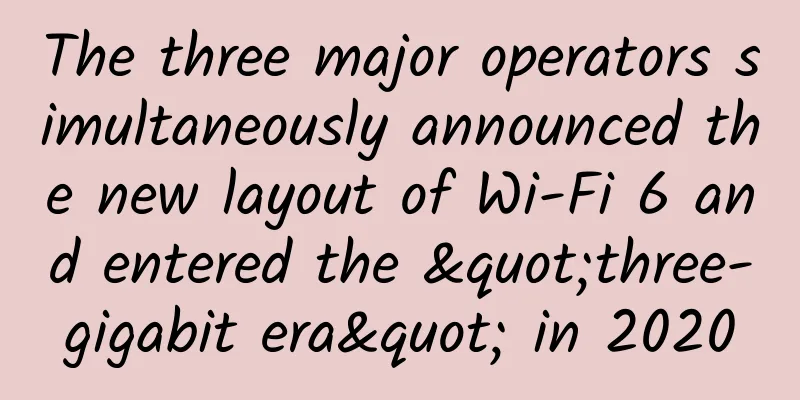The three major operators simultaneously announced the new layout of Wi-Fi 6 and entered the "three-gigabit era" in 2020

|
Recently, the three major operators have made corresponding arrangements for Wi-Fi 6. China Mobile expects to fully enter the Wi-Fi 6 era in September 2020, while China Unicom and China Telecom have announced the entry into the "three-gigabit era". A recent report released by IDC predicts that the scale of Wi-Fi 6 in the Chinese market alone will be close to US$200 million in 2020. From this point of view, 2020 may become the first year for Wi-Fi 6 to officially enter the market.
On the same day, it was announced that the Wi-Fi 6 deployment plan will be fully commercialized by the end of this year As early as 2019, the Wi-Fi 6 standard was officially released, especially the latest version of the IEEE 802.11 wireless LAN standard, which provides compatibility with previous network standards, including the current mainstream IEEE802.11n/ac. The Institute of Electrical and Electronics Engineers defined it as IEEE 802.11ax, and the Wi-Fi Alliance responsible for commercial certification called it Wi-Fi 6 for the convenience of publicity and promotion. Compared with Wi-Fi 5, Wi-Fi 6 has a maximum rate of 9.6Gbit/s and a minimum latency of 10ms. It can support up to 128 people surfing the Internet at the same time, helping terminals reduce power consumption by about 30%. At the 5G Ecosystem Partner Conference held on May 17, China Mobile stated that it will further promote network upgrades and promote 100% of urban OLT (optical line terminal) equipment to have gigabit platform capabilities; promote the upgrade of home networking equipment, with gigabit coverage of 50 million households; promote the transition from single-frequency gateways to dual-frequency gateways, and from single gateways to gateway + smart networking. China Mobile will start centralized procurement of Wi-Fi 6 related equipment in the second half of 2020, and is expected to realize Wi-Fi 6 commercial use in June 2020, fully enter the Wi-Fi 6 era in September 2020, and is expected to develop smart networking services for 20 million households and achieve 5 million Wi-Fi 6 users in 2020. On the same day, Shanghai Telecom announced the launch of the "broadband + 5G + Gigabit Wi-Fi" three-gigabit upgrade, fully launched the Gigabit Wi-Fi network upgrade supporting Wi-Fi 6, and will create a number of benchmark and demonstration application scenarios. It is understood that Shanghai Telecom has completed the ChinaNet large-scale Wi-Fi 6 Gigabit coverage and pilot launch in public areas such as high-speed railways, commercial plazas, and botanical gardens. China Unicom also held a "Unicom Triple Gigabit" press conference on May 17, announcing that China Unicom has entered the "Triple Gigabit" era and will fully deploy Wi-Fi 6 gigabit terminal products to accelerate the rapid popularization of home gigabit services. It is expected that by the end of this year, China Unicom will provide Wi-Fi 6 networking services in all gigabit broadband coverage areas, and 50,000 professional smart home engineers across the country will provide users with one-stop whole-house smart solution services. The logic behind the timing nodes: Wi-Fi 6 will boost the wireless market Why did the three major operators choose to vigorously promote the construction and layout of Wi-Fi 6 at this point in time? Li Jie, director of the Cloud Broadcasting R&D Center of China Unicom's 5G Innovation Center, said that the growth rate of the Wi-Fi 5 product market gradually slowed down in 2019, but users' network access and application needs gradually became prominent. The rapid development of 5G also drove the growth of Wi-Fi 6 to some extent. Therefore, the Wi-Fi 6 standard officially released in 2019 should be commercialized as soon as possible to boost the entire wireless market. my country has a complete and functional Wi-Fi industry chain, and some companies also occupy a leading position internationally. Li Jie believes that, especially since the outbreak of the COVID-19 pandemic, users' demand for Wi-Fi quality has surged, stimulating chip and terminal manufacturers to accelerate technology research and development and product plans, and my country also has the conditions and strength to promote the rapid commercialization of Wi-Fi6. Industry analyst Jin Feng also believes that from the supply side perspective, products (such as routers, etc.) are already relatively mature, and can be promoted on a large scale in terms of price, and various newly released networked terminals (mobile phones, tablets, PCs, etc.) also support Wi-Fi6. Take China Unicom as an example. It has been following the development of Wi-Fi 6 technology since 2018, completed the technical performance test of Wi-Fi 6 chip level in October 2019, and jointly launched new Wi-Fi 6 products with the industry chain during the "517 World Telecommunication Day" in 2020, promoting the maturity of domestic technology while quickly completing the overall layout of the product market. "We can regard 2020 as the first year that Wi-Fi 6 officially enters the market." Li Jie said. Jin Feng further analyzed from the demand side and said: "Ultra-high-speed network connection is the key point. This not only involves user needs, but also the government's evaluation of speed increase and fee reduction also focuses on the experience speed." He believes that "new infrastructure" also requires the improvement of infrastructure capabilities. To this end, operators need to achieve ultra-high-speed network coverage in all scenarios, and Wi-Fi6 is the best choice. On the one hand, it can make up for the problem of insufficient speed of indoor wireless network coverage (the last 10 meters); on the other hand, it can divert 5G, including diversion of scenarios with insufficient indoor coverage construction and diversion of users who are unwilling to use traffic indoors. Entering the "three-gigabit" era, the industrial chain has gained greater market space Triple Gigabit is an upgrade of dual Gigabit. "Use Gigabit 5G when going out, and Gigabit broadband and Gigabit Wi-Fi when entering." Li Jie believes that this is the best practice of operators for the network power strategy and 5G new infrastructure requirements, and is a further upgrade of information infrastructure construction. Operators focus on providing high-quality basic networks, and through the construction of "triple gigabits", they actively promote the development of digital life and the digitalization, networking, and intelligent transformation of the economy and society. Wi-Fi6 will bring greater market space to the industry chain and bring users richer innovative business experience. Jin Feng believes that for operators, in the context of a substantial expansion of access capacity, simply expanding the metropolitan area network and backbone network cannot cope with the scenario of explosive growth in data volume. Therefore, it is necessary to further promote the construction of intelligent networks around business and data, and limit the large-scale flow of data through an integrated cloud-pipe-edge strategy to ensure business quality. For enterprises in the industry, this is clearly a new opportunity worth taking. Jin Feng said that all kinds of equipment manufacturers can benefit from the upgrade of network terminals (including home hotspots and public hotspots) and network expansion; all kinds of content and application manufacturers can provide content with higher service quality (such as ultra-high-definition video) and provide cloud services based on high QoS, such as cloud VR, cloud games, cloud hosting, etc. "Three Gigabits" can create a three-dimensional high-speed Internet access environment for users covering all scenarios of home, work, and travel, fully meeting users' various network access and application needs. Li Jie said that operators and industry partners will work together to build a Wi-Fi 6 terminal ecosystem. By fully deploying Wi-Fi 6 Gigabit products, it will accelerate the popularization of home Gigabit broadband services, bring more innovative services to users, and promote the upgrade of user information consumption. Can “Three Gigabits” help operators return to the “Golden Age”? Will Wi-Fi6 be another powerful tool for operators to return to the "golden age"? Jin Feng believes that if operators only pursue the level improvement of general infrastructure and continue to provide undifferentiated services to the industry, the situation of increasing volume but not increasing revenue will continue, and operators will not be able to return to the "golden age". "Objectively speaking, the commercial use of Wi-Fi 6 products does not mean that its industry chain is mature enough." Li Jie said that Wi-Fi 6 has brought opportunities to the industry, but also faces many challenges. For example, the price is what users are most concerned about. The first batch of Wi-Fi 6 products released by some router manufacturers in the second half of 2019 cost two to three thousand yuan, but they are still in the range of three to five hundred yuan. This shows that the cost of the product is still high and the technology is difficult. Most users are taking a wait-and-see attitude towards it, and it still takes time to cultivate users' acceptance of Wi-Fi 6 products. In addition, as users' demands for networking services such as home network latency and bandwidth become more and more clear, Wi-Fi 6 has also put forward higher requirements for the improvement of the service system. If operators want to return to the "golden age", they must exert a strong influence on the upstream and downstream of the industry and change "universal" to "differentiated", Jin Feng said. For example, they can charge manufacturers based on business optimization, or expand the scope of "infrastructure" that can be operated, including edge computing, AI computing power, data centers, etc., to achieve indivisible integrated operations. At this stage, the full commercial use of Wi-Fi 6 requires the coordinated promotion of multiple factors, that is, new 5G terminals need to fully support Wi-Fi 6, the price of Wi-Fi 6 routing products needs to be further reduced, high-bandwidth content such as video needs to be further enriched, and operators need to encourage users to replace their devices, so that users can "use it, use it, and have it in hand". Wi-Fi 6 will not be replaced by 5G There are many voices in the industry about whether Wi-Fi 6 and 5G can coexist "in harmony but in difference". Wi-Fi 6 has many technical features that overlap with 5G, especially when operators are actively promoting 5G indoor distribution and 5G industry applications, and traffic charges are further reduced. Will Wi-Fi 6 scenarios be replaced by 5G in the future? Li Jie said that the two are irreplaceable and they complement each other. To be precise, Gigabit 5G, Gigabit broadband, and Gigabit Wi-Fi complement each other. "For operators, Gigabit Wi-Fi is an important scenario supplement for dual-gigabit networks. When the concentration of wireless devices increases rapidly, Wi-Fi can reduce the connection pressure of base stations and improve network utilization. For users, the cost of using Wi-Fi will still be lower than that of 5G networks for a long time, which is more convenient for home networks, especially enterprise LAN networking and application services, and is conducive to indoor ultra-high-definition video, smart device interconnection and other applications and scenario linkage." Li Jie said. Jin Feng also believes that Wi-Fi 6 scenarios will not be replaced by 5G for three reasons: First, the habit of using Wi-Fi indoors and data traffic when going out is difficult to change in the short term; second, a large number of not-so-wealthy consumers still "save as much as they can", especially in third- and fourth-tier cities and rural areas; third, in terms of access cost, if the minimum stable goal of 100 megabits is to be achieved, the cost of Wi-Fi 6 is much lower than the cost of 5G base stations, and operators also need to divert traffic in an orderly manner, especially massive traffic such as video. In the future, the joint application of Wi-Fi 6 technology and 5G will help build a low-cost, full-scenario, full-touch, three-dimensional high-speed Internet access environment, and help accelerate the evolution of network facilities towards high-speed ubiquity. |
>>: Σco Time | Grasping new trends, Hunan's smart campus transformation is accelerating
Recommend
NGINX Official Test Center was established to release exams and certifications to provide skills upgrade for Chinese NGINX users
On April 8, 2021, the NGINX Official Authorized C...
5G has entered its ramp-up phase, and this key factor determines its success or failure...
[[414891]] This article is reprinted from the WeC...
Understand 5G-A multi-frequency coordination—“3CC” in one minute
picture Speaking of "3CC", we must ment...
F5 Launches F5 Advanced WAF for Multi-Cloud Application Security
Beijing, China, May 14, 2018 – This week, F5 (NAS...
HostDare: CN2 GIA line CSSD series 15% discount from $30/year, CKVM series 10% discount from $45/year
HostDare continues to offer discount codes for CN...
HortonworksTed Yu: China's participation in international exchanges is accelerating
[Original article from 51CTO.com] On November 25-...
How unified communications technologies can support long-term remote work
[[354214]] Organizations implementing long-term r...
Ministry of Industry and Information Technology: Cancellation of data "roaming" fees will be implemented as scheduled in 2018
The State Council executive meeting on April 4 cl...
Talk about what you want to know and don't know about SDN
SDN has been very popular for a while. For a whil...
The pain of transformation in the gaming industry is evident as Digital Sky successfully breaks through with the help of Huawei Cloud
[51CTO.com original article] In 2017, the total r...
5G networks are moving towards cloud, virtualization and network slicing
As some telecom operators seek to accelerate the ...
How can operators easily get on the battlefield in the 5G era? 4.5G will take on the heavy responsibility
With the arrival of 5G, maintaining 2G, 3G, 4G, a...
Have you already moved to SDN network?
Today's networks are constantly changing and ...
Perhaps it is easier to understand HTTPS this way
We won’t talk about HTTP and HTTPS first. Let’s s...
Kunpeng spreads its wings and walks with youth | Kunpeng University Tour Shanghai Jiao Tong University special session explores technology, practice and innovation
On the afternoon of December 4, the first stop of...



![[Black Friday] Justhost has a 30% discount for a limited time, 22 data centers in Russia, the United States, Singapore, etc. are available](/upload/images/67cabce3ceaff.webp)





